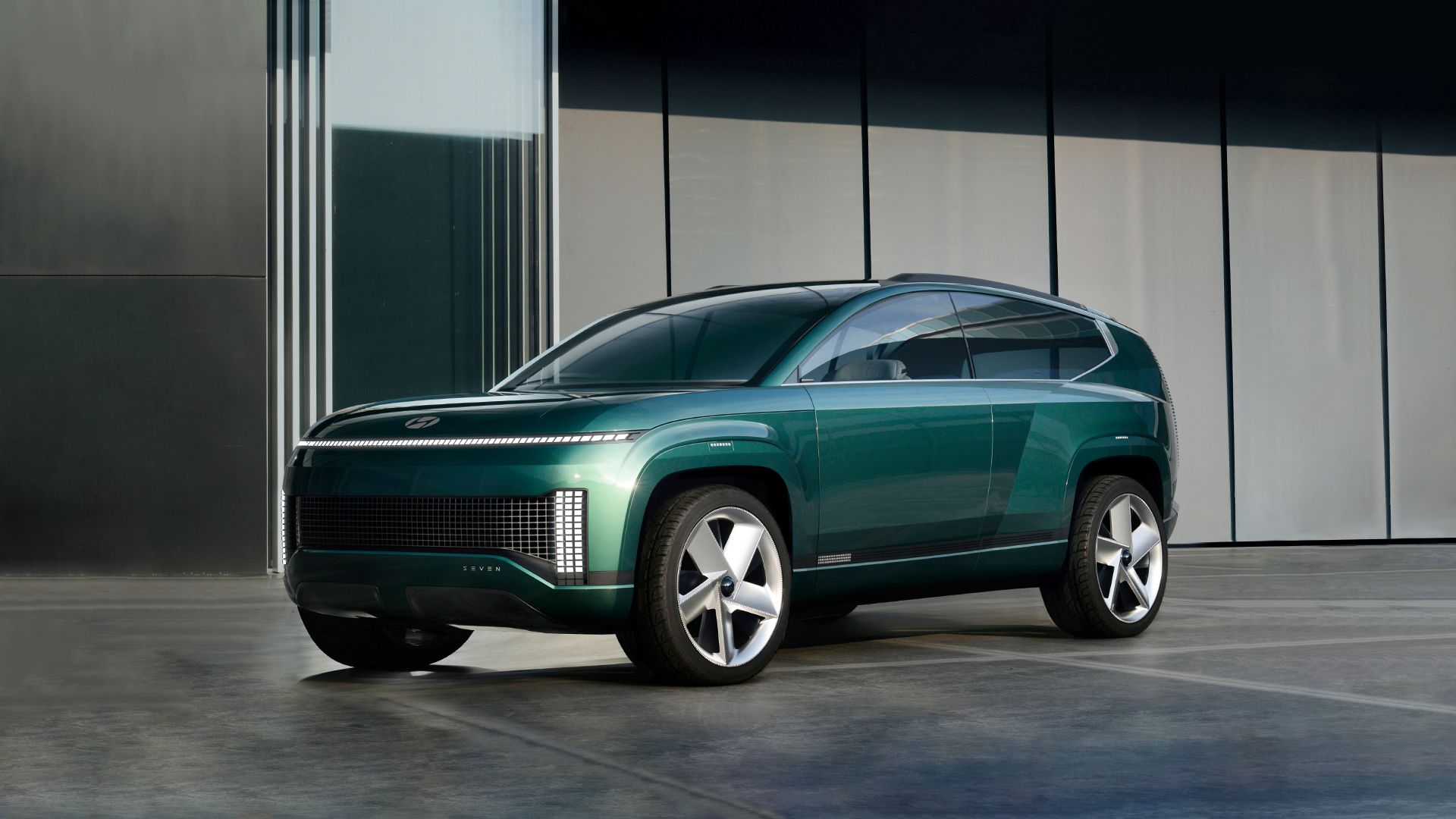
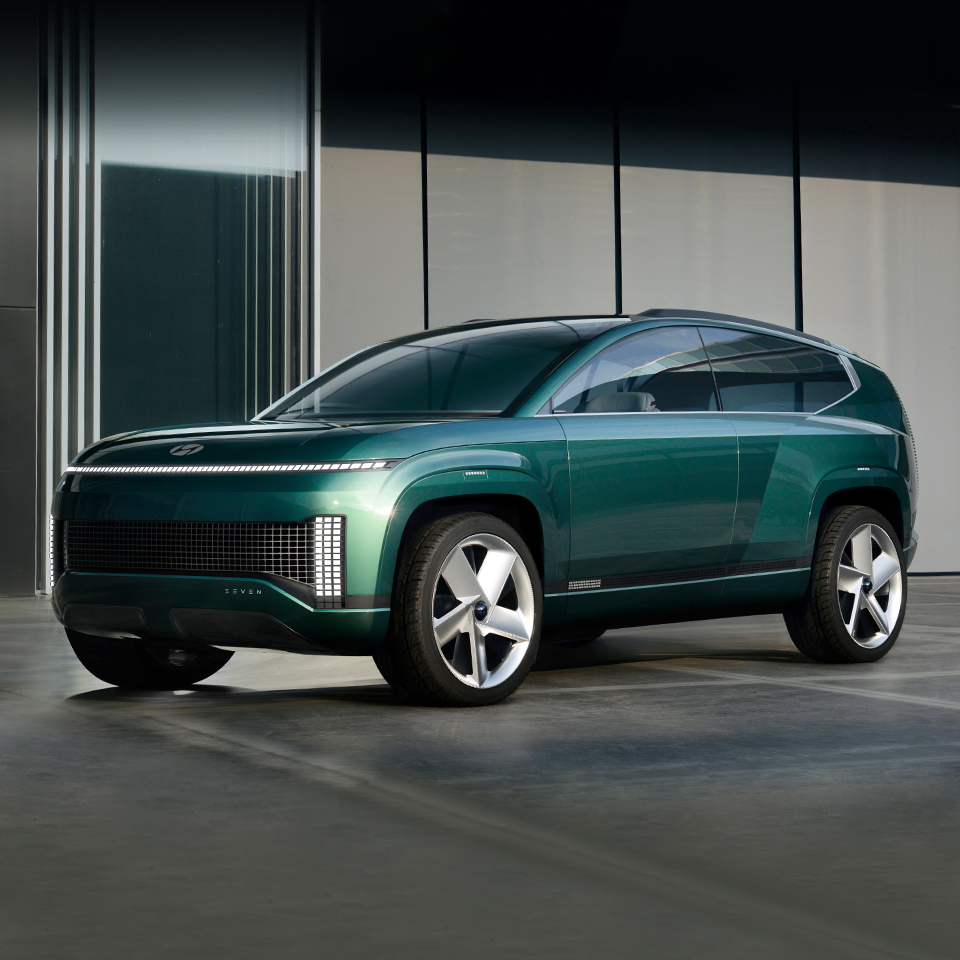


Governments have increased the scale and level of carbon emission reductions in recent years to be carbon neutral - as necessary to combat climate change. Global automakers are also rapidly promoting electrification.
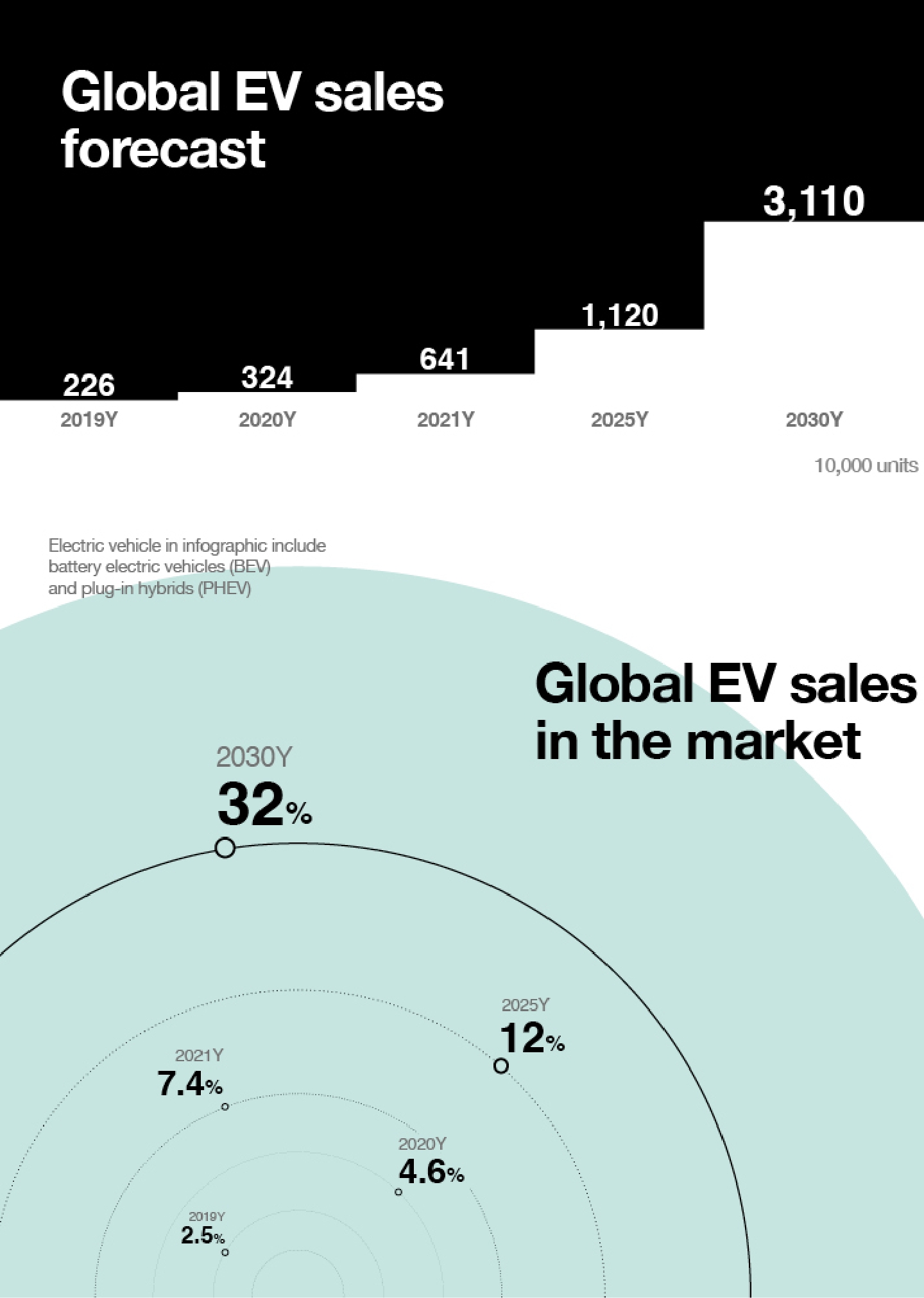
According to energy research firm Bloomberg New Energy Finance (BNEF), to achieve carbon neutrality by 2050, as declared by governments, 60% of all new car sales must be made up of zero-emission vehicles - such as electric vehicles - by 2030. Here is a detailed roadmap of governments and automakers around the world to boost the era of decarbonization and electric vehicles.
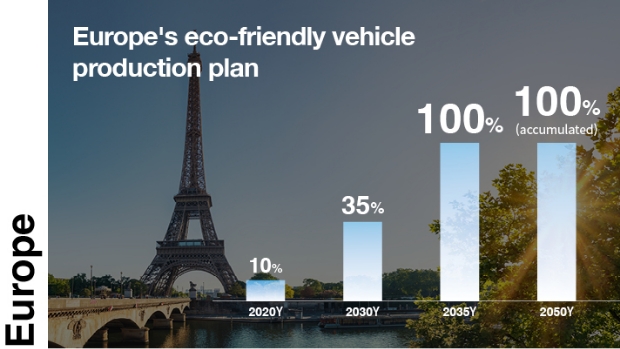
The European Commission has set the goal of becoming the world's first carbon-neutral continent and aims to reduce greenhouse gas emissions by at least 55% by 2030 compared to 1990 levels. Based on the current carbon emission of 95 g CO₂/km for passenger cars and 147 g CO₂/km for small commercial vehicles, the carbon emission regulation of automobiles will be reduced by 15% until 2025 and will be strengthened step by step every 5 years thereafter. plan. Then, by 2030, the reduction level for passenger cars will be increased from 37.5% to 55% and small commercial vehicles from 31% to 50%. At the same time, by 2030, 35% of new vehicles sold across Europe will consist of only eco-friendly vehicles such as electric vehicles, and sales of new vehicles with internal combustion engines will be completely banned starting from 2035. It will only be possible to sell and distribute zero-emission vehicles (ZEVs) such as pure electric vehicles (BEVs) and hydrogen-electric vehicles (FCEVs) or plug-in hybrids (PHEVs) with low carbon emissions. The plan is to phase out internal combustion engines in Europe after 2050.
Mercedes-Benz recently revised its electrification strategy from 'Electric First' to 'Electric Only' and announced a swift implementation plan. By 2022, the automaker will introduce electric vehicles (BEVs) to its entire lineup, and all new cars to be unveiled from 2025 will house one of three electric vehicle-only architectures - 'MB.EA', a mid-size passenger car, and 'AMG. EA', or commercial vehicle 'VAN.EA'. Through this, the entire lineup will be converted to electrified models by 2030.
BMW is also accelerating the electrification of electric vehicles with its electric vehicle brand 'i'. Recently, it launched a new flagship model, ix, and started to expand the market. By 2023, it plans to introduce 13 new electric vehicles and fill 90% of its entire lineup, including the high-performance brand M, with pure electric vehicles. Based on this, it plans to achieve cumulative sales of 2 million electric vehicles by 2025, and increase the proportion of electric vehicles in total sales to more than half by 2030. It also has a plan to supply about 10 million electric vehicles to the global market by 2030.
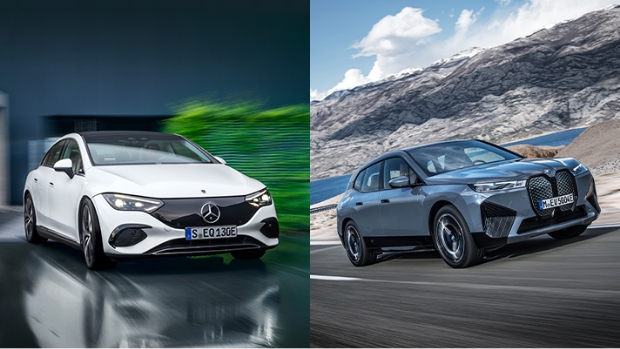
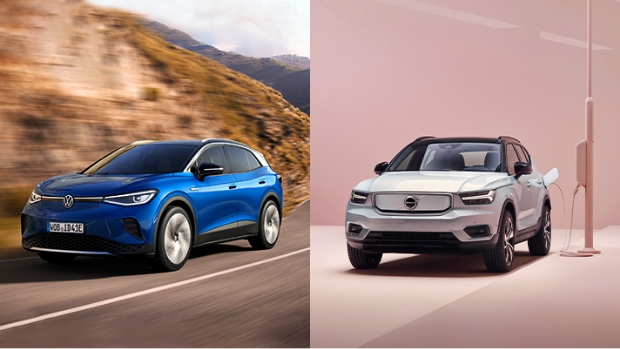
The Volkswagen Group is expected to be decarbonized by 2030 according to the group's mid-to-long-term strategy New Auto. By 2025, 73 billion euros will be invested in the development of future technologies, mainly in the electrification and digitalization sectors, to develop the integrated architecture mechatronics platform SSP (Scalable Systems Platform) and integrated battery cells. The electric car that houses the SSP is scheduled to be produced from 2026, so that by 2030, half of Volkswagen's new models will be electric. Audi has set a goal of being completely carbon-neutral by 2050 by phasing out the production of internal combustion engines by 2033, with only electric vehicles expected to be available from 2026.
Volvo is also spurring electrification, starting with its first electric vehicle, the XC40 Recharge, released earlier this year. The strategy is to sell 1 million electric vehicles to the global market by converting 50% of total production to electrified models by 2025. The remaining 50% are hybrid models, and while these will also be reduced in stages, it plans to manufacture only completely zero-emission vehicles in 2030. Through this, the automaker plans to become the first global premium brand with 100% electrification.
The United States is implementing an eco-friendly policy to reduce carbon emissions to less than half of 2005 levels by 2030. The key to carbon policy in the transport sector is the installation of charging stations. With a strategy of using charging infrastructure to overcome the obstacles to purchasing electric vehicles - the single-charge range -, it plans to invest $7.5 billion by 2030 to install more than 500,000 charging stations. President Biden announced a plan to increase the proportion of electric vehicle sales to 50% by 2030, and plans to pass a bill that subsidizes up to 50% of the purchase price of American electric vehicles.
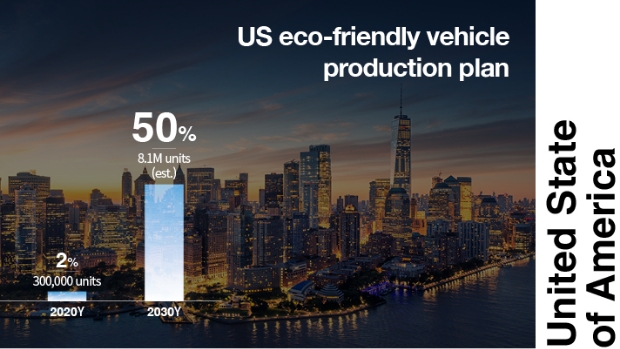
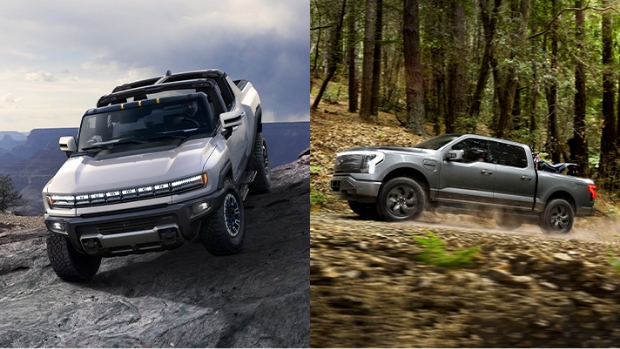
General Motors (GM) plans to increase its electric vehicle market share through the Ultium platform and Ultium battery system exclusively developed for electric vehicles. By 2025, it will invest $35 billion in electric and autonomous vehicles to continue developing the current second-generation Ultium, and based on this, the automaker plans to introduce 30 new EV models. In addition to GMC's electric pickup truck Hummer EV, the automaker's other brands - Chevrolet and Buick - will also launch a variety of models next year. In addition, the company announced its goal to raise its electric vehicle production capacity to 1 million units per year and to become the market leader by 2030. In 2035, the automaker plans to produce only electric vehicles in major markets such as the United States and China, and in the global market by 2040.
Ford decided to realize economies of scale through vertical integration to not only survive in the electrification era but also to emerge as the second-biggest manufacturer within two years. Vertical integration means that all stages of work - from production to sales - are carried out through its sub companies. This way, the electric vehicle production capacity will increase to 600,000 units per year within two years, and by 2035, the automaker will be able to sell only electric vehicles in major markets and in the global market from 2040. Ford's market strategy begins with the electric pickup truck F-150 Lightning, which will be introduced in the first half of next year, and then will add EV models to its entire lineup by 2024.
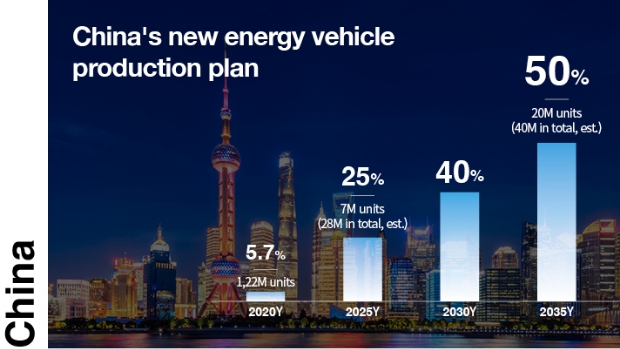
China, the world's largest carbon emitter, will achieve carbon neutrality by 2060, about 10 years later than other countries. However, in terms of transportation strategy, more aggressive policies are being implemented than in other countries. Through the ‘New Energy Automobile Industry Development Plan’, the country has decided to raise the proportion of new energy vehicles including EVs to 20% of total new car sales by 2025. After then, it plans to manufacture at least 20 million new energy vehicles out of 40 million new cars by expanding its production to 40% in 2030 and more than 50% in 2035. At the same time, it is expected to gradually reduce the proportion of internal combustion engines by banning the sale of new vehicles with internal combustion engines.
China's three major EV makers are also entering the market with their own unique strategies. Nio chose battery replacement, not charging. The replacement method refers to charging power by replacing a used battery with a previously charged battery at a station. Nio has built 300 Power Swap Stations, a battery replacement infrastructure, across China in the first half of this year, and plans to add 100 more by 2025. In addition, the number of stations in operation will be expanded to 15,000 in the future, and following the automaker's signature models - eS8, eS6, and eC6 - the company plans to introduce four additional new models by 2022 to increase its market share.
Xiaofeng's strength is its single-charge range. Last year, it introduced the sports sedan P7 with a maximum driving range of 706km on a single charge and announced that it will sell 50% electric vehicles in China and 50% overseas. BYD has succeeded in internalizing batteries and is increasing its market dominance. Through the vertical integration of production, more than 80% of electric vehicle parts are produced in-house to secure price competitiveness, and it is also producing semiconductors for its own automobiles. It plans to sell only electric vehicles in key markets by 2035 and worldwide from 2040.
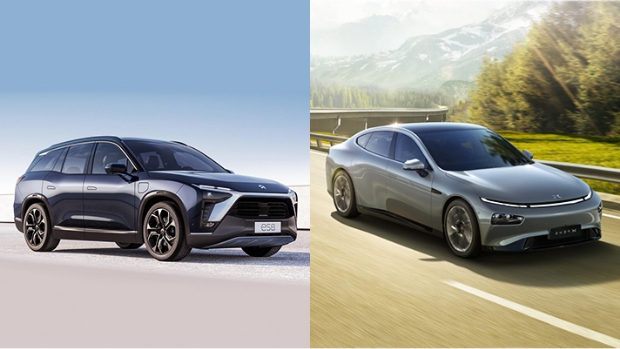
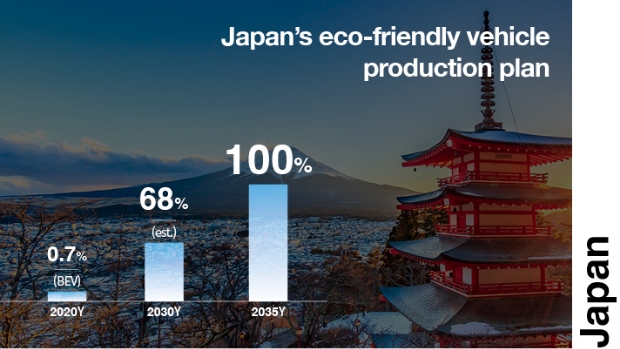
As part of its decarbonization policy, Japan is phasing out sales of internal combustion engines, and has decided to completely ban them by 2035. In addition, it will support the expansion of charging infrastructure to expand the supply of electric vehicles, as well as support the electrification of the current auto parts manufacturers and direct investment. However, Japan's 100% eco-friendly car conversion includes hybrid cars equipped with both an internal combustion engine and a motor.
As the three Japanese automakers were little late in developing electric vehicles, they started to develop ‘the ultimate battery,’ an all-solid-state battery. Toyota was the first among global automakers to start developing all-solid-state batteries, and before this, the company announced the launch of an electric model by unveiling its electric vehicle-only brand, bZ. Starting with the bZ4X, an electric SUV scheduled to be released in 2022, 15 types of electric vehicles (BEVs) will be introduced by 2025, including commercial vehicles, and 30 types of electric vehicles (BEV) by 2030. The strategy is to eliminate internal combustion locomotives from the product lineup by 2050. Lexus plans to introduce electric vehicles to its entire lineup by 2030 and convert all models sold in the global market to EVs by 2035.
Honda is also developing an all-solid-state battery with the goal of the late 2020s. The company has a strategy to start trial production of all-solid-state batteries before the first quarter of next year, and introduce electric vehicles with all-solid-state batteries in the late 2020s. In addition, following the small electric hatchback Honda e launched last year, the company plans to launch an electrified model by adding an electric SUV early next year. The automaker aims to increase the proportion of eco-friendly car sales to up to 70% by 2030, and plans to expand this to 80% by 2035 and change 100% to electric vehicles and hydrogen-electric vehicles in 2040.
Nissan also recently announced an electrification strategy focusing on the development of all-solid-state batteries. In order to increase the proportion of electric vehicle sales to 50% by 2030, it will invest 2 trillion yen to develop its own batteries and electric vehicles over the next five years. It plans to release 20 new electric vehicles by 2027 and three more by 2030. After that, Nissan plans to sell only electric vehicles and hybrid vehicles in Japan, the United States, China, and Europe, and ultimately only produce electric vehicles and hydrogen-electric vehicles.
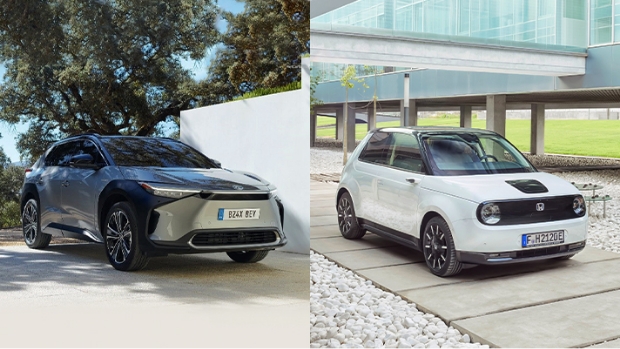
To achieve carbon neutrality, Korea plans to reduce greenhouse gas emissions by 40% compared to 2018 by 2030. To achieve this, it plans to manufacture 4.5 million eco-friendly vehicles such as electric vehicles and hydrogen-electric vehicles. In detail, it plans to increase the sales of eco-friendly cars, which accounted for 12% (226,000 units) of total new car sales in 2020, to 910,000 units, or 51%, by 2025, and 83%, or 1.5 million units, by 2030. In addition, it plans to install more than 500,000 charging infrastructures by 2025. In addition, the government plans to lower barriers for electric vehicles by supporting the localization of electric vehicle parts materials and the development of dedicated platforms.
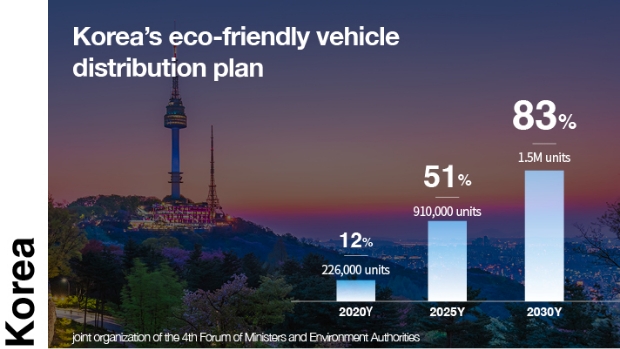
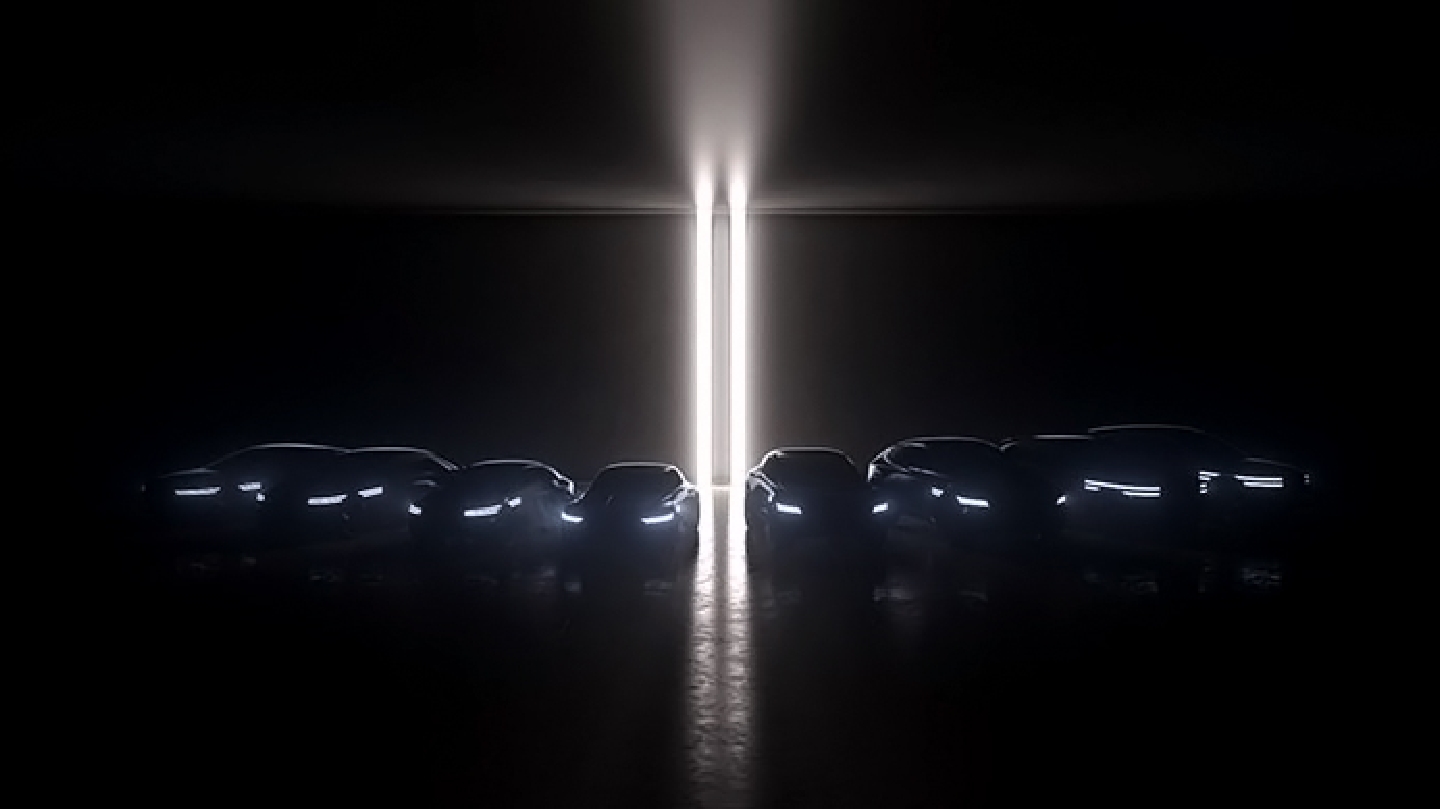
Hyundai Motor Group has proven its competitiveness in the global electric vehicle market since the debut of the IONIQ 5 this year. Hyundai Motor Group's exclusive electric vehicle being crowned the car of the year by various groups and media outlets around the world, including North America and Europe, highlights the fact.
Genesis plans to launch only electric or hydrogen-electric vehicles from 2025 under the ‘Futuring Genesis’ strategy. In addition, it plans to produce a total of eight electrified model lineups by 2030 and expand sales to 400,000 units annually in the global market. As part of this strategy, Genesis recently introduced electrified models of the G80 and GV70, as well as the dedicated electric vehicle GV60. The automaker is committed to becoming a carbon-neutral brand by 2035, not only by electrifying internal combustion engines, but also by reducing carbon emissions across the entire value chain, from raw materials to production.
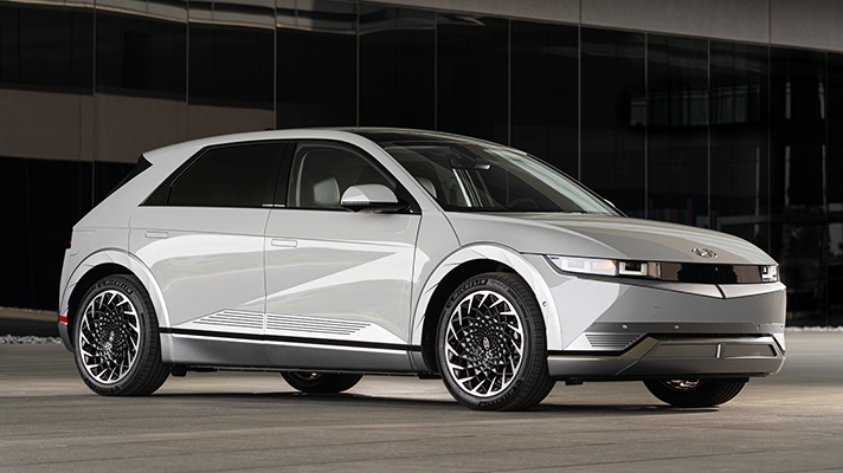
Hyundai Motor plans to increase the proportion of electrified vehicles to 30% in 2030 and 80% in 2040 to become carbon neutral in 2045. Currently, Hyundai is introducing an electric vehicle lineup through IONIQ, a pure electric vehicle brand that applies E-GMP, a platform dedicated to electric vehicles. Following the IONIQ 5, which received a great response worldwide this year, the company plans to launch two new electric vehicles, a mid-size sedan and a large SUV. Back in 2020, the concept car Prophecy was unveiled, allowing people to predict what the second model of the IONIQ brand will look like; And recently, the automaker also announced the electric SUV concept car SEVEN, a large SUV that will be the third lineup of IONIQ at the LA Auto Show.
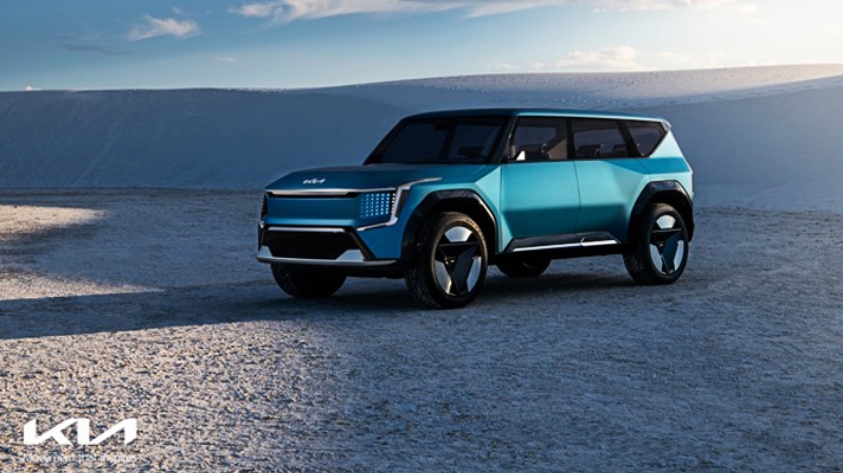
Kia plans to become a sustainable mobility brand through the mid-to long-term strategy ‘Plan S’. By 2027, Hyundai Motor Group will introduce seven new dedicated electric vehicles that house E-GMP, the exclusive electric vehicle platform of Hyundai Motor Group. Starting with the EV6, Kia set a goal of securing a 6.6% share of the global electric vehicle market by 2025 and achieving annual sales of 500,000 electric vehicles by 2026. The Kia Concept EV9, the first large electric SUV concept that was recently unveiled, also shows Kia's strategy. Through this, the automaker plans to become a truly eco-friendly brand by selling only electrified models from 2035 in Europe and 2040 in major markets.
Global consulting firm Deloitte forecasts that the share of electric vehicles in the global automobile market will increase to 32% by 2030, compared to about 4% in the global automobile market last year. It is said that 3 out of 10 cars on the road are electric vehicles. As governments around the world and major global automakers are taking active actions to achieve carbon neutrality and rapidly transitioning to electrification, the era of electric vehicles is fast approaching. Everyone is looking forward to the life that eco-friendly mobility electric vehicles will change in the future.
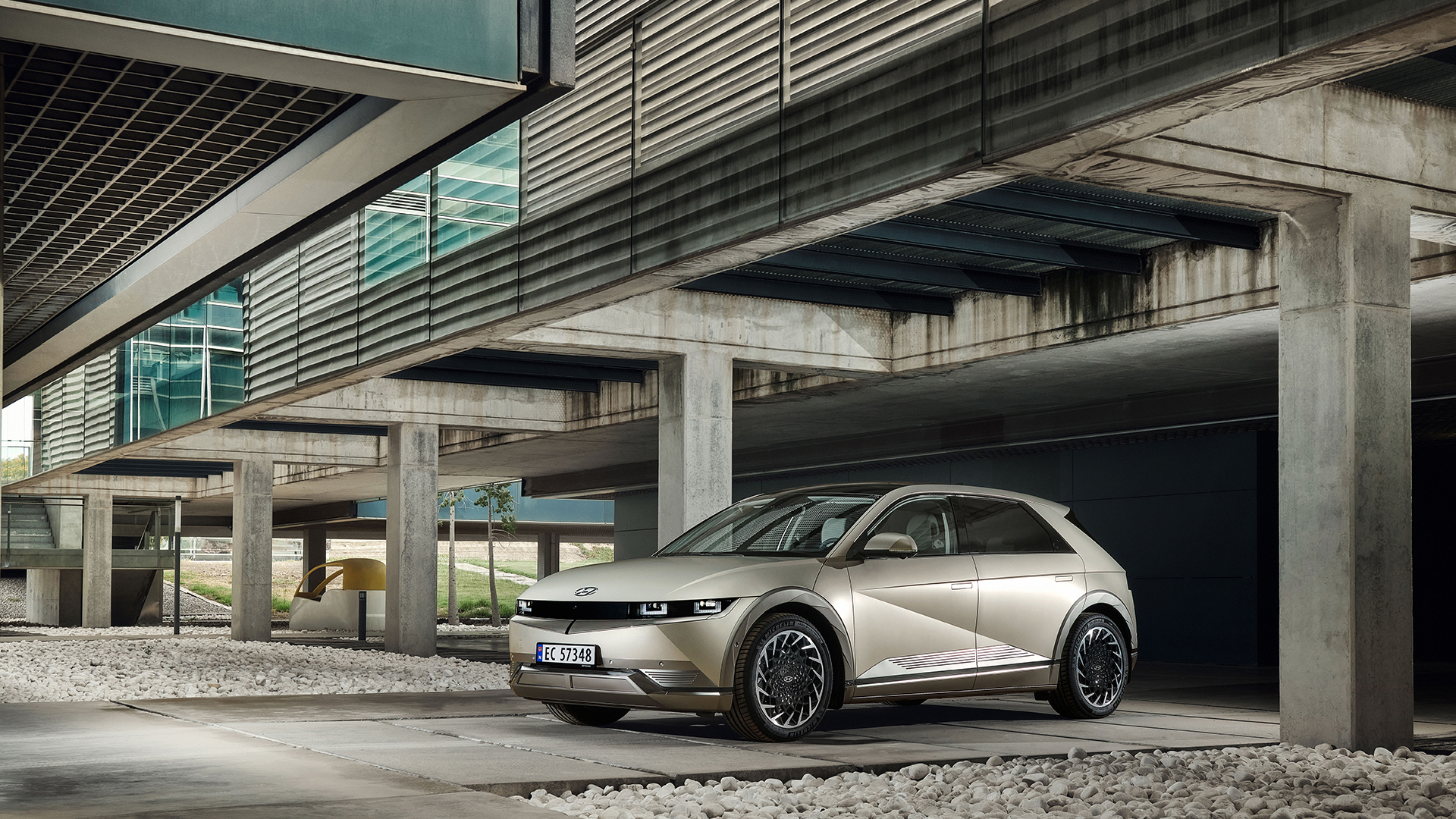
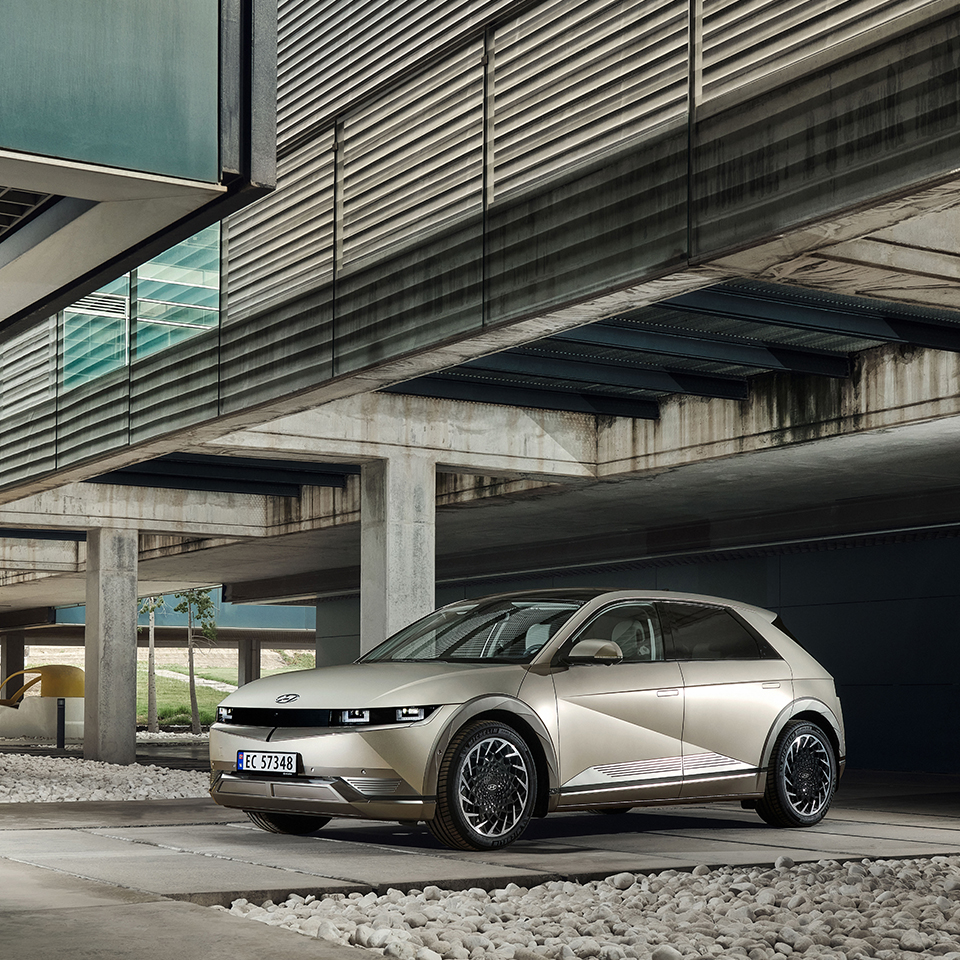
Auto Zeitung Chooses IONIQ 5 and EV6 In the Comparison Test
2022.03.07 9min read